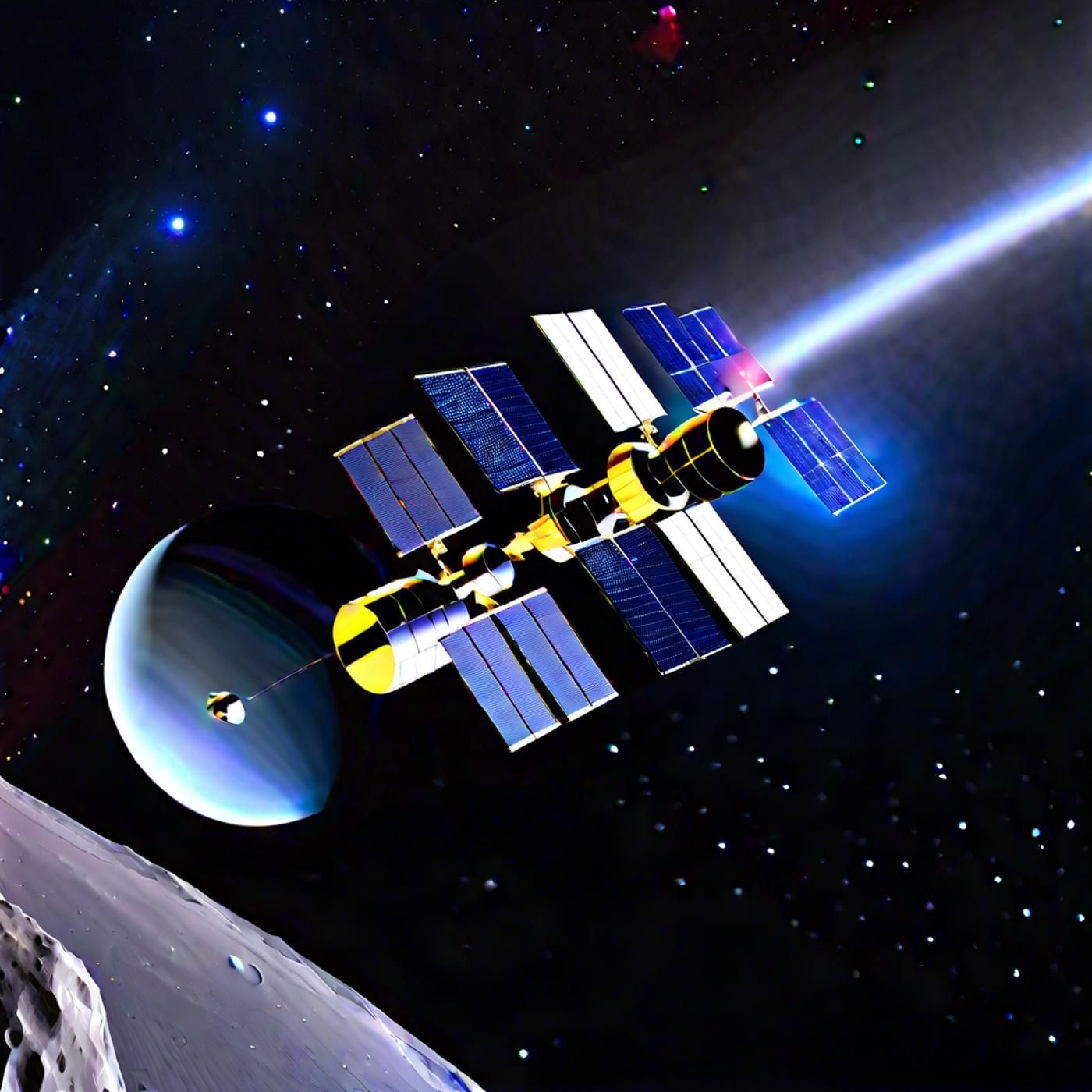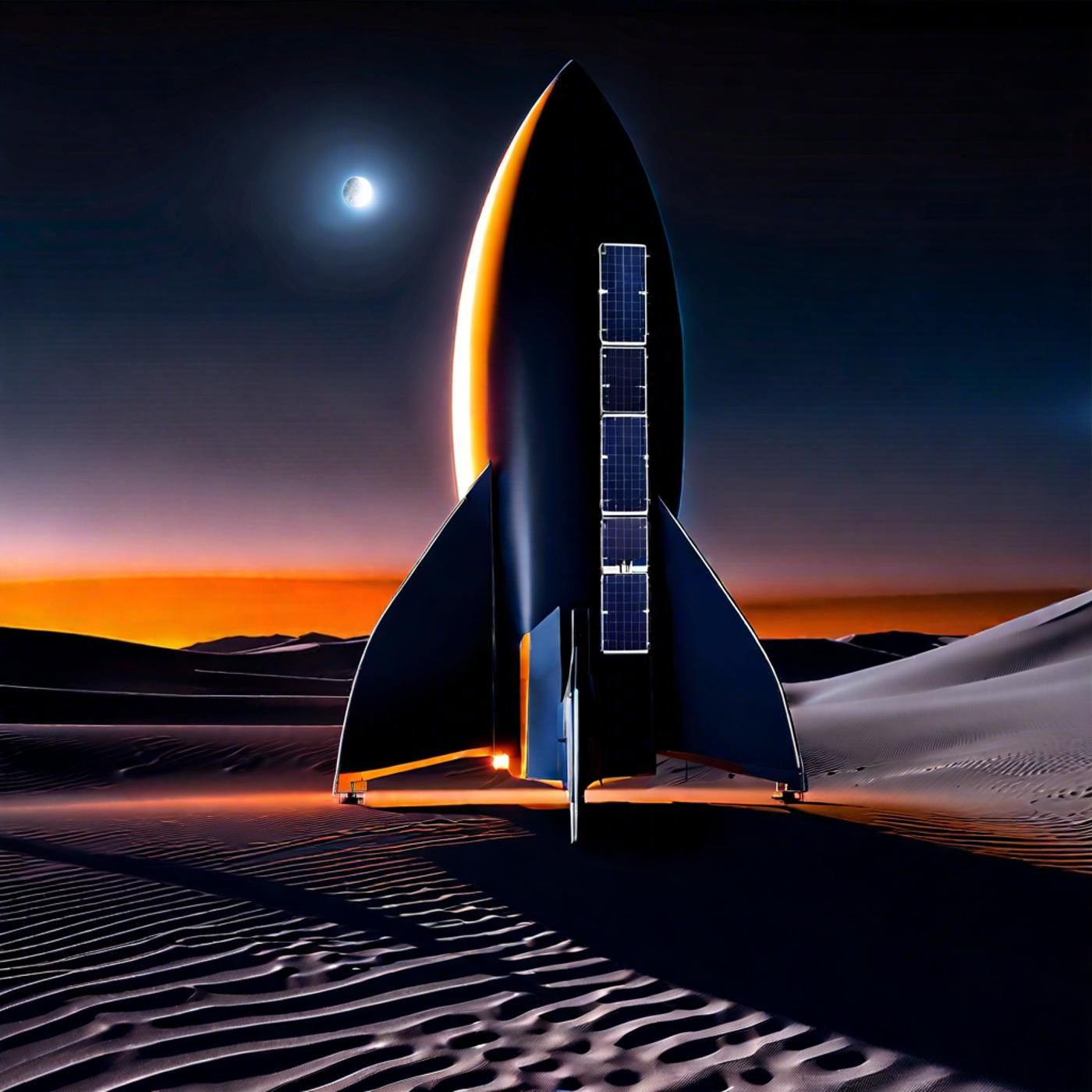S03E78: Black Hole Mysteries & Rocket Lab's Historic Deal

Embark on a celestial journey with today's episode of Astronomy Daily - The Podcast, where your host, Anna, brings you the latest cosmic updates. We'll delve into groundbreaking research on the secrets of supermassive black holes, a historic launch...
Embark on a celestial journey with today's episode of Astronomy Daily - The Podcast, where your host, Anna, brings you the latest cosmic updates. We'll delve into groundbreaking research on the secrets of supermassive black holes, a historic launch deal by Rocket Lab, and a preview of upcoming space missions and cutting-edge lunar developments in China. There's plenty to keep you informed and inspired.Astronomers have long been fascinated by supermassive black holes, the titanic giants residing at the heart of most galaxies. Recent research by Amri Bartos and Oscar Barrera from the University of Florida offers intriguing insights into how these black holes grow to such incredible sizes. Their study suggests that black holes created through mergers carry information about their predecessors, challenging the notion that black holes are simple objects. This research is particularly timely as the field of gravitational wave astronomy is blossoming, providing new tools for studying these phenomena.Exciting news from the world of space technology as Rocket Lab has signed its largest electronic launch deal to date with the Japanese Earth observation company Synspective. This monumental agreement includes a commitment to ten additional launches between 2025 and 2027, solidifying Rocket Lab as Synspective's exclusive launch provider. This partnership aims to enhance various applications, including infrastructure maintenance, agricultural efficiency, and disaster response.The past week in the spaceflight industry was filled with scrubs and delays, but the skies are about to get busier. SpaceX, Rocket Lab, and China's CASC are gearing up for a series of significant missions. SpaceX is preparing for two Falcon 9 missions, Rocket Lab is marking its 50th launch, and China is launching the SVOM telescope to observe gamma ray bursts. These upcoming launches are a testament to the global and collaborative nature of space exploration.The commercial and scientific race to the Moon is heating up with planned bases near the south pole by 2035. While the Moon offers an unparalleled platform for astronomical observations, mining operations for water and helium-3 pose a threat to these scientific endeavors. The International Astronomical Union has formed the working group Astronomy from the Moon to address these conflicts, aiming to create a balanced approach where scientific exploration and commercial enterprise can both thrive.In a noteworthy advancement, Chinese scientists have successfully conducted a critical test of the YF-100K engine, a propulsion system pivotal for the Long March 10 rocket. This test signifies a vital step towards China's goal of achieving sustained manned missions and establishing a long-term human presence on the Moon. China's advancements in lunar technology bolster its capabilities for future manned missions and signify its growing presence in the international space exploration arena.Kyocera's fine cordierite ceramic mirror is making waves aboard the International Space Station. This advanced material, chosen for its exceptional thermal and mechanical properties, is crucial for high-precision optical communication between the ISS and Earth. This technology offers a solution for high-speed, high-capacity data transfer, with significant implications for weather forecasting, disaster response, surveillance, and infrastructure monitoring.
For an astronomical experience, visit our website at astronomydaily.io for the latest news, sign up for our free newsletter, and check out exclusive sponsor deals.
Connect with us on YouTube, TikTok, X, and Facebook via @AstroDailyPod for engaging discussions with fellow space aficionados. This is Anna, reminding you to keep your gaze fixed on the heavens. Until our next stellar episode, let the cosmos ignite your curiosity and wonder. Clear skies and cosmic...
Astronomy Daily brings you the latest in astronomy news and discoveries
Anna: Welcome to Astronomy Daily, your trusted source for the latest in astronomical discoveries and space news. I'm your host, Anna, and today we have an exciting lineup of stories to share with you. From groundbreaking research on the secrets of supermassive black holes in a historic launch deal by rocket Lab to a preview of upcoming space missions and cutting edge lunar developments in China, there's plenty to keep you informed and inspired. We'll also delve into the balance between scientific exploration and commercial endeavors on the moon and the latest advancements in optical communications aboard the International Space Station. Let's get started.
New research suggests black holes created through mergers carry information about their predecessors
Astronomers have long been fascinated by the secrets held within supermassive black holes, the Titanic giants that reside at the heart of most galaxies. These celestial enigmas, with masses millions or even billions of times that of our sun, defy the conventional understanding of stellar evolution. They cannot simply be created from the collapse of massive stars, prompting scientists to explore how these black holes grow to such incredible sizes. Recent research by Amri Bartos and Oscar Barrera from the University of Florida offers intriguing insights into this cosmic mystery. Their study suggests that black holes created through mergers carry information about their predecessors, a discovery that could revolutionize our understanding of black hole formation. The researchers delve into the concept of daughter black holes, which emerge from the collisions of smaller parent black holes. According to Bardos, these daughter black holes retain characteristics of their ancestors, such as spin and mass. This enduring fingerprint challenges the notion encapsulated by physicist John Wheeler's famous phrase, black holes have no hair, which implies that black holes are simple objects defined only by mass, spin, and electric charge. Bartos and Barrera focused particularly on the spin of black holes. High spin rates can result from black holes consuming surrounding gas or merging with others, while lower spin rates are often associated with black holes formed from the collapse of stars. By using a mathematical technique called bayesian inference, the researchers were able to infer the spin properties of ancestral black holes based on observed data. This research is particularly timely as the field of gravitational wave astronomy is blossoming. Gravitational waves, ripples in SpaceTime caused by violent cosmic events like black hole mergers, have provided new tools for studying these phenomena. Recent observations hint that black hole assembly lines, regions where multiple black holes merge consecutively, might be common throughout the universe. Bardos and Barrera's work is a fascinating glimpse into the cosmic detective story of uncovering the lives of black holes. As, uh, gravitational wave detectors become more sophisticated, we may soon be able to trace the history of these enigmatic giants and understand the processes that govern their growth. This study is a testament to the ever evolving nature of astronomical research and the continuous quest to unlock the secrets of the universe.
Rocket Lab signs largest electronic launch deal with Japanese Earth observation company Syn Spective
Exciting news from the world of space technology as Rocket Lab has just signed its largest electronic launch deal to date with the japanese Earth observation company Syn Spective. This monumental agreement, announced in Tokyo, includes a commitment to ten additional launches between 2025 and 2027. Rocket Labs electron launch vehicle, already a trusted partner for Synspective since 2020, will continue to play a crucial role in deploying their synthetic aperture radar or SAR satellites. These satellites are crucial for Synspectiv's mission to monitor millimeter level changes on Earth's surface. The new agreement not only solidifies Rocket Lab as Synspectiv's exclusive launch provider, but also allows for two launches scheduled for this year from Rocket Lab's launch complex, one in New Zealand. This partnership provides synspective with unparalleled control over their launch schedule and deployment parameters, optimizing their satellite constellations effectiveness. Rocket Lab founder and CEO Sir Peter Beck expressed his enthusiasm, highlighting the importance of this collaboration in supporting Japan's rapidly growing space industry. He emphasized the unique contribution of Rocket Lab, a, uh, us rocket company utilizing a New Zealand launch site, in offering tailored access to orbit for japanese satellites. Synspectives founder and CEO doctor Motoyuki Arai echoed this sentimental expressing confidence in rocket Labs innovative capabilities and the critical role they play in advancing synspectives environmental and economic monitoring services. This deal underscores the strategic importance of collaborations in the space industry, combining cutting edge technology with robust international partnerships. Synspective plans to use the extended satellite constellation to enhance various applications, including infrastructure maintenance, agricultural efficiency and disaster response. New Zealand's Prime Minister Christopher Luxon lauded the agreement, noting its significance in strengthening trade and cooperation between Japan and New Zealand. He highlighted the exemplary nature of this international collaboration in broadening the horizons of space technology and fostering economic growth. This historic deal not only marks a milestone for rocket lab and synspective, but also represents a significant leap forward in global efforts to utilize space technology for the betterment of life on Earth.
SpaceX and CAS C gearing up for significant missions this week
The past week in the spaceflight industry was a rare lull filled with scrubs and delays, but the skies are about to get busier than ever. This week, SpaceX rocket Lab and China's CAS C are gearing up for a series of significant missions that promise to advance our understanding and utilization of space. First up, SpaceX is preparing for two Falcon nine missions launching from separate coasts in the United States. From Cape Canaveral, Florida, SpaceX will launch the Astra one P SES 24 mission, which has already faced weather related delays. This mission aims to deploy a wide beam television satellite into geostationary orbit, providing extended coverage and improved image quality for viewers in Europe. Following shortly, another Falcon nine will lift off from Vandenberg, California, carrying the first group nine Starlink satellites. These 20 new satellites, equipped with direct to cell capabilities, will join the ever expanding Starlink constellation, enhancing global Internet connectivity. Both missions will attempt to land their boosters on autonomous drone ships, showcasing SpaceXs reusability prowess yet again. Meanwhile, rocket Lab is preparing to mark a milestone with its 50th launch, dubbed the no time to loose mission. Scheduled to launch from New Zealand's Mahia Peninsula, this mission will deploy five kinase nanosatellites into low Earth orbit. These satellites are part of a french initiative to create a constellation that reduces revisit time between satellite passes, enhancing the monitoring and management of Internet of things IoT devices globally. Not to be outdone, China is also stepping up with its Changjiang two C rocket set to launch the satellite variable objects Monitor SvOM telescope. This mission, a joint venture between China and France, will help observe gamma ray bursts from space, providing crucial data that could unlock new mysteries about the universe. The SvOm telescope will detect gamma bursts, contributing to our understanding of stellar explosions and the formation of black holes. These upcoming launches are a testament to the global and collaborative nature of space exploration. From enhancing global communication networks and observational capabilities to unlocking new cosmic mysteries, the coming weeks promise a rapid resumption and acceleration of space activities. Whether it's the United States, New Zealand, or China, the race to the stars continues to pick up pace, pushing the boundaries of what humanity can achieve in space. The commercial and scientific race to the Moon is heating up with planned bases near the south pole by 2035. This burgeoning interest is driven by its unique advantages, near constant solar power and the promise of water ice in permanently shadowed craters. While these conditions make it an ideal location for both human habitats and scientific instruments, they also bring about significant challenges in ensuring both endeavors can coexist harmoniously. The moon offers an unparalleled platform for astronomical observations. Its lack of atmosphere and minimal radio interference make it a pristine site for telescopes that cant be built on Earth. For example, the far side of the moon is perfect for low frequency radio astronomy, and the frigid craters at the poles could house highly sensitive infrared telescopes. Furthermore, the stable environment could support advanced gravitational wave detectors, potentially transforming our understanding of the universe. However, the very activities that enable human survival on the moon, like mining for water and helium three pose a threat to these scientific endeavors. Mining operations create vibrations that could compromise the sensitivity of delicate instruments. Additionally, planned communications and GPS satellite constellations around the moon may emit radio frequencies that interfere with crucial astronomical observations. Interestingly, the International Astronomical Union has formed the working group astronomy from the moon to address these conflicts. This group seeks to identify and protect key lunar sites from potentially disruptive activities. The goal is to create a balanced approach where scientific exploration and commercial enterprise can both thrive. This collaboration between researchers, astronauts, and commercial entities aims to ensure that the moon's scientific potential isn't sidelined by commercial interests. It's a delicate balancing act, but with careful planning and international cooperation, both goals can be achieved. As we look forward to this new era of lunar exploration, it's crucial that we maintain the integrity of our scientific pursuits while supporting the technological advancements driven by commercial ventures.
Chinese scientists have successfully conducted a critical test of the YF 100K engine
Um, in a noteworthy advancement, chinese scientists have successfully conducted a critical test of the YF 100K engine, a propulsion system that is pivotal for the long March 10 rocket. This test signifies a vital step towards China's ambitious goal of achieving sustained manned missions and establishing a long term human presence on the moon. The ignition test, performed at an engine testing facility in Beijing's Fengtai district, saw three YF 100K engines working in unison, generating a combined thrust of 382 metric tons. This powerful engine setup will serve as the backbone of the Long March 10 rocket, which is currently under development by the China Academy of Launch Vehicle Technology, a subsidiary of the China Aerospace Science and Technology Corporation. The long March 10 is designed to be a formidable launch vehicle, standing at 92.5 meters tall and possessing a liftoff weight of 2189 tons. With a thrust capability of 2678 tons, it will be able to transport spacecraft weighing at least 27 tons to an Earth moon transfer trajectory. Its primary mission will involve transporting Chinas next generation crewed spacecraft and landing modules to lunar orbit, with a tentative maiden flight scheduled around 2027. China's first manned lunar expedition is set to involve two consecutive launches of the long March 10 from the Wencheng Space Launch center in Hainan province. The plan is to transport a landing module and a manned spacecraft into lunar orbit, where they will dock and allow astronauts to descend to the moon's surface for scientific exploration and sample collection. This mission is a significant leap forward for China's space program, which has already seen six successful robotic moon missions. Among these, the Chang'e five and Chang'e six missions, have notably deployed two rovers and retrieved valuable lunar samples. Moreover, a modified version of the long March 10, which omits the side boosters is also being developed. This variant, standing at 67 meters tall with a liftoff weight of 740 tons, will be utilized to transport astronauts and cargo to the Tiangong space station in low Earth orbit. China's advancements in lunar technology not only bolster its capabilities for future manned missions, but also signify its growing presence and competitiveness in the International Space Exploration arena.
Ceramic mirror being used for laser communication between ISS and Earth
M Kyocera's fine cordierite ceramic mirror is making waves as it takes on a groundbreaking role aboard the International Space Station. This advanced material has been chosen for its exceptional thermal and mechanical properties, which are crucial for the high precision required in optical communication between the ISS and Earth. The adoption of this ceramic mirror is part of a larger initiative led by Sony Computer Science laboratories in collaboration with several top tier institutions, including Japan's Ministry of Internal affairs and Communications, the National Institute of Information and Communications Technology, NICT, and the University of Tokyo. This cutting edge project seeks to address the growing need for rapid and reliable data transmission from space. Why is this significant? Traditional communication methods that use radio waves or visible light have their limitations, particularly when it comes to the sheer volume of data that modern earth observation satellites can capture. With the sensors on these satellites becoming more advanced, the demand for high speed, high capacity data transfer has never been higher. This is where laser light optical communication comes into play. It offers a solution that is not only faster, but also capable of handling significantly larger amounts of data. One of the key challenges in utilizing optical communication is ensuring the light signals are directed with pinpoint accuracy. This is where Kyocera's fine cordierite ceramic mirror excels. Unlike metal or glass mirrors, which can be prone to thermal expansion and mechanical instability in the harsh conditions of spring, Chiacera's ceramic mirror maintains its structural integrity and precise dimensions over time. This stability is critical for maintaining the accuracy needed to direct laser light from the ISS to a mobile ground station on Earth. The implications of this technology are vast. Enhanced optical communication can lead to better weather forecasting. By providing more timely data. It can improve disaster response times by quickly relaying crucial information from affected areas. Additionally, it has applications in surveillance and infrastructure monitoring, where rapid data transmission can be vital. With the successful integration of kyoceras ceramic mirror in this project, we are poised to see significant advancements in how we communicate with and utilize data from space. This development is a testament to the ongoing innovation in space technology and its potential to solve some of our most pressing challenges here on earth. And that's it for today. Thank you for tuning into this episode of Astronomy Daily. I've been your host, Anna. For more from the team, be sure to visit our website at astronomydaily. IO. Our constantly updating newsfeed and access to all our episodes are, uh, just a click away. You can also follow us on social media at AstroDailyPod, find us on YouTube, X, Facebook, and TikTok. We appreciate your support and your passion for the cosmos. Until next time, keep looking up.
New to Astronomy Daily - The Podcast?
Here are some great episodes to start with.




















